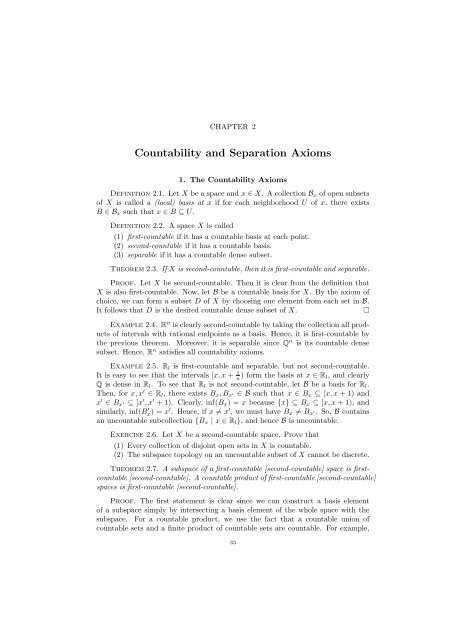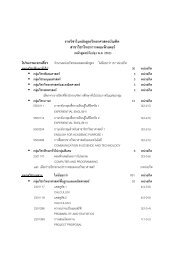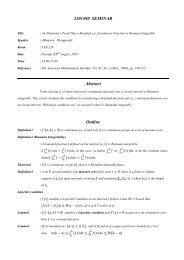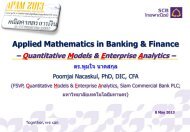Lecture Notes Topology (2301631) Phichet Chaoha Department of ...
Lecture Notes Topology (2301631) Phichet Chaoha Department of ...
Lecture Notes Topology (2301631) Phichet Chaoha Department of ...
You also want an ePaper? Increase the reach of your titles
YUMPU automatically turns print PDFs into web optimized ePapers that Google loves.
CHAPTER 2<br />
Countability and Separation Axioms<br />
1. The Countability Axioms<br />
Definition 2.1. Let X be a space and x ∈ X. A collection B x <strong>of</strong> open subsets<br />
<strong>of</strong> X is called a (local) basis at x if for each neighborhood U <strong>of</strong> x, there exists<br />
B ∈ B x such that x ∈ B ⊆ U.<br />
Definition 2.2. A space X is called<br />
(1) first-countable if it has a countable basis at each point.<br />
(2) second-countable if it has a countable basis.<br />
(3) separable if it has a countable dense subset.<br />
Theorem 2.3. If X is second-countable, then it is first-countable and separable.<br />
Pro<strong>of</strong>. Let X be second-countable. Then it is clear from the definition that<br />
X is also first-countable. Now, let B be a countable basis for X. By the axiom <strong>of</strong><br />
choice, we can form a subset D <strong>of</strong> X by choosing one element from each set in B.<br />
It follows that D is the desired countable dense subset <strong>of</strong> X.<br />
□<br />
Example 2.4. R n is clearly second-countable by taking the collection all products<br />
<strong>of</strong> intervals with rational endpoints as a basis. Hence, it is first-countable by<br />
the previous theorem. Moreover, it is separable since Q n is its countable dense<br />
subset. Hence, R n satisfies all countability axioms.<br />
Example 2.5. R l is first-countable and separable, but not second-countable.<br />
It is easy to see that the intervals [x, x + 1 n ) form the basis at x ∈ R l, and clearly<br />
Q is dense in R l . To see that R l is not second-countable, let B be a basis for R l .<br />
Then, for x, x ′ ∈ R l , there exists B x , B x ′ ∈ B such that x ∈ B x ⊆ [x, x + 1) and<br />
x ′ ∈ B x ′ ⊆ [x ′ , x ′ + 1). Clearly, inf(B x ) = x because {x} ⊆ B x ⊆ [x, x + 1), and<br />
similarly, inf(B x) ′ = x ′ . Hence, if x ≠ x ′ , we must have B x ≠ B x ′. So, B contains<br />
an uncountable subcollection {B x | x ∈ R l }, and hence B is uncountable.<br />
Exercise 2.6. Let X be a second-countable space. Prove that<br />
(1) Every collection <strong>of</strong> disjoint open sets in X is countable.<br />
(2) The subspace topology on an uncountable subset <strong>of</strong> X cannot be discrete.<br />
Theorem 2.7. A subspace <strong>of</strong> a first-countable [second-countable] space is firstcountable<br />
[second-countable]. A countable product <strong>of</strong> first-countable [second-countable]<br />
spaces is first-countable [second-countable].<br />
Pro<strong>of</strong>. The first statement is clear since we can construct a basis element<br />
<strong>of</strong> a subspace simply by intersecting a basis element <strong>of</strong> the whole space with the<br />
subspace. For a countable product, we use the fact that a countable union <strong>of</strong><br />
countable sets and a finite product <strong>of</strong> countable sets are countable. For example,<br />
33





